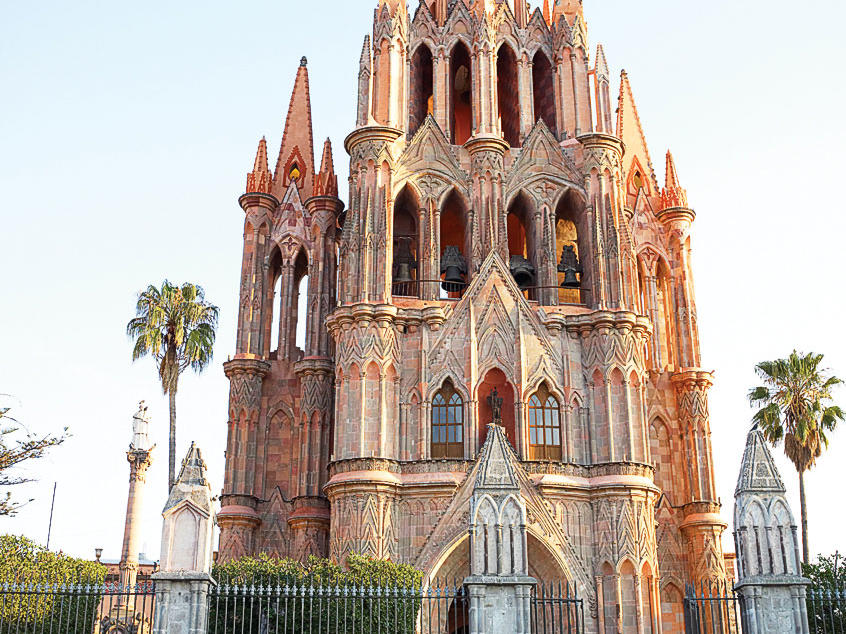
Falling for San Miguel

People love San Miguel de Allende, Mexico. They love San Miguel so much that when you tell them you’re making your first visit, their love annoys you. San Miguel will change your life, they say. Yeah, right, you think. The architecture, the culture. I’ve seen old buildings, you mutter, I’ve seen lots of old buildings.
So you make the flight to Leon, in central Mexico, and the hourlong taxi ride, and you’re in San Miguel. And just as all the annoying people warned you, you’re in love.
Here, on the slopes of the Mexican altiplano, is a city that reminds you of parts – the best parts – of Santa Fe, of Siena, of Seville. But it’s maybe more beautiful than any of them, especially now, in spring, when the clear, high air – the city stands at about 6,000 feet – is tinted violet by hundreds of blooming jacarandas.
YOU LAND AND YOU LOOK
“This is El Jardín, San Miguel’s central square,” says the guide on the 10 a.m. city walking tour. My gauge of how hard I’ve fallen for a place is how long it takes me to recover from the plane ride and start exploring: in San Miguel, about one minute.
“Once, all the teenagers did the traditional paseo here,” the guide says, “the girls walking in one direction, the boys in the other, flirting.” Now, she adds, “They’re like North American kids, hanging all over each other everywhere.”
Some things change. Others don’t. In the 18th century, San Miguel thrived as a trading and textile center. Wealthy factory owners and merchants built grand mansions and helped fund even grander churches. Today much of that opulence remains.
From El Jardín, the tour crosses the street to La Parroquia de San Miguel Arcángel, the most prominent of San Miguel’s many churches. A lot of Mexican churches are heavy, dour affairs, each stone cautioning you not to sin. Not La Parroquia.
“The man who designed La Parroquia was not a trained architect,” our guide says. “One story is that he was inspired by postcards of European cathedrals.” Or maybe by Marvel Comics: La Parroquia is a pink rocket ship shooting into the sky. The guide points to the church bell tower. “There are four bells. Each has a name. St. Michael, for the archangel Michael, is the oldest. But La Luz has the purest sound.”
Once on your own, you learn to use La Parroquia both as signpost and clock. From every corner of the city, its rose tower guides you when you’ve lost your way. The clanging of La Luz and St. Michael marks the hours of the gently passing days.
You learn other lessons too. The most painful is “don’t walk and look at the same time.” Many of San Miguel’s streets date from the 18th century: They’re cobblestone, wildly uneven, brutal on the unwary ankle. One local shoe store promotes a San Miguel Shoe for women, allegedly engineered to prevent sprains. But, inevitably, you will walk and look and invariably twist your ankle. You will not care.
MYSTERIES REVEAL THEMSELVES
San Miguel can seem almost unbearably beautiful. The churches whose roof tiles curl like the wings of fallen angels, the houses whose colors are pulled from the Earth’s core – lava reds, sulfurous ochers. But there’s an aloofness to this beauty too. Windows are shuttered. Each brilliant house has a forbidding front door – heavy, iron hinged, and, you think, forever closed.
Then. Doors open. You are permitted to peer in shyly. What do you see? In one courtyard, a blazing purple bougainvillea; in another, a sleeping dachshund. A woman painting a watercolor.
As you explore, you get the feeling that no city on Earth contains as many hidden lives as this one does, nor so great a sense of possibilities. Even for the visitor, San Miguel is generous in sharing its secrets. Each doorway, you learn, reveals a life you might be leading too; every courtyard is a chance for you to become someone new. Because in this city it’s remarkably easy to meet people – people, you realize, who have fallen hard too.
“After the war, my father came from Okinawa to San Miguel,” says local landscape architect Tim Wachter. “He was an artist who came down to check out the scene. Some people say there’s a lode of magnetic quartz under the town that makes people stay.”
Wachter’s father belonged to the first wave of Americans in San Miguel: soldiers who came to study Spanish or art or anthropology on the GI Bill and remained here to live. Now there is a new wave, generally younger, often richer, who come for a chance to reimagine their lives.
Open the weekly bilingual newspaper Atención San Miguel – essential reading for any visitor – and you feel like you’re reading the course catalog for an ambitious liberal arts college. Spanish classes! Chess classes! Chamber music performances! Body work and massage therapy and dream interpretation!
Drama coach Taylor Korobow and architect Joseph Kent moved to San Miguel from the Bay Area after years of vacationing here. “In San Miguel,” Kent says, “you feel all the possibilities. The package has been unwrapped.”
“People change when they come here,” adds Korobow. “They become the person they always wanted to be.”
YOU RELAX AND FIND YOUR RHYTHM
The person you always wanted to be. Maybe it’s the third day, or the fourth day, of your visit that this person begins to emerge: more relaxed, more aware of the surrounding world, more fun.
By now you’ve developed a rhythm. You know that the best way to explore is to set a destination in mind but understand that you will be diverted from it. Say, for example, you want to see the Oratorio de San Felipe Neri in part because you’ve heard the best tamales in town are found at a stand in front of it.
You start out, crossing leafy, tropical Parque Benito Juárez, but here are 50 women doing Zumba – a locally popular exercise regimen – to Christina Aguilera’s “Candyman” and next to them, sometimes interrupting them, a pickup basketball game. So you watch for a while and then walk up Calle Jesús to expat Mary Marsh’s excellent little bookstore, Libros El Tecolote, and then somehow find yourself at the escuela de Bellas Artes, sipping coffee in a courtyard that, in a city of fine courtyards, is finest of all. And you haven’t even made it to the tamales. (You will later, and they will indeed be the best in the world.)
In the same indirect way, you begin to acquire some Spanish. You stumble over nouns and verbs the way you stumble over the cobblestones. But San Miguel is famous for its language schools, and its people are used to Americans mixing up jabón (soap) for jamón (ham). They smile, they nod, they understand that you do not in fact want to order eggs with soap.
And the language starts to flow. At first, only in the present tense. But that is fine: In San Miguel, you don’t need to deal with past or future, just with now. La iglesia es muy bonita, you say at San Felipe Neri. The church is very pretty. And, Los tamales son muy ricos.
AND THEN YOU’RE OFFICIALLY IN LOVE
When does it hit you – the certainty that you will return to San Miguel? Maybe it’s when you find yourself scanning the apartments-for-rent advertisements in Atención. Or at night when El Jardín turns into San Miguel’s answer to the multiplex, with bands and dance troupes and people hawking roast corn, and you think, There’s no way in the world I’ll never come back here.
For me it was on the Sunday House & Garden Tour, a local institution that combines San Miguel’s love for real estate, charity (proceeds go to the city library), and snooping. Each Sunday, you get to tour three homes that would be otherwise closed to you.
Fifty of us pile into school buses. Our first house is in the Fábrica La Aurora, a former textile factory now turned into stores, galleries, restaurants, and a few living spaces: more SoMa or SoHo than classic Mexico. Then House Number Two: a whimsical collection of casitas, each painted in Crayola colors, with folk art everywhere.
As we walked around admiring the houses, I thought, I could live here. In the first house, I’d wear severe suits and shout on the phone to New York. In the second, I’d become an expert on Mexican muralists.
Then the final house, a more traditional family home with, as it happens, the family on hand to greet us. We stroll through the cocina, the sala and end up in the courtyard – lush even by San Miguel standards and now occupied by the mother of the house and the family parrot. The parrot speaks many Spanish words, but his favorite is ¡Gordo! ¡Gordo! Fat! Fat!
By now my Spanish is good enough to talk to, and about, the parrot.
“Aquí está un loro,” I say to the woman. Here is a parrot.
“Sí.”
“¿Cuántos años tiene?” How old is he?
“Veinte.” Twenty.
I am worried now that the parrot will look at me and shriek, “¡Gordo!” Even so, I realize that I very much do not want to leave. I want to stay in the courtyard, acquiring new stories, listening to St. Michael and La Luz chime the hours, becoming the person I want to be.
I look the parrot in its beady eyes. Its owner looks at me, smiling but puzzled. Yo voy a volver, I tell him. I’m going to return. Pronto, pronto. Soon, soon.
